
The Divine Lady is a 1929 American pre-Code Vitaphone sound film with a synchronized musical score, sound effects, and some synchronized singing, but no spoken dialogue. It stars Corinne Griffith and tells the story of the love affair between Horatio Nelson and Emma Hamilton. It featured the theme song "Lady Divine", with lyrics by Richard Kountz and music by Nathaniel Shilkret, which became a popular hit in 1929 and was recorded by numerous artists, such as Shilkret, Frank Munn, Ben Selvin, Smith Ballew, Adrian Schubert, Sam Lanin, and Bob Haring.

Our Dancing Daughters is a 1928 American synchronized sound drama film starring Joan Crawford and John Mack Brown about the "loosening of youth morals" that took place during the 1920s. The film was directed by Harry Beaumont and produced by Hunt Stromberg. While the film has no audible dialog, it was released with a synchronized musical score with sound effects using both the sound-on-disc and sound-on-film process.
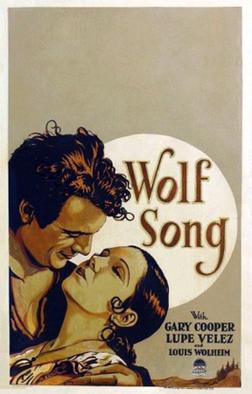
Wolf Song is a 1929 American sound part-talkie Western romance film directed by Victor Fleming and starring Gary Cooper and Lupe Vélez. While the film has a few sequences with dialog, the majority of the film featured a synchronized musical score with sound effects using both the sound-on-disc and sound-on-film process.
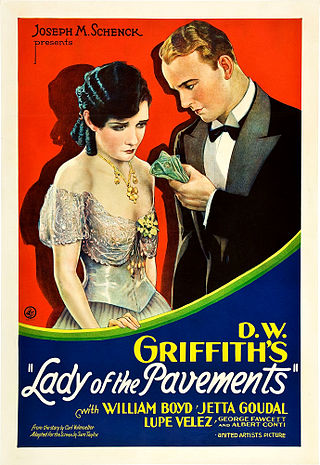
Lady of the Pavements is a 1929 American sound part-talkie romantic drama film directed by D. W. Griffith and starring Lupe Vélez, William Boyd, and Jetta Goudal. The screenplay was written by Sam Taylor, with contributions from an uncredited Gerrit Lloyd. While the film has a few talking sequences, the majority of the film features a synchronized musical score with sound effects using both the sound-on-disc and sound-on-film process.

Children of the Ritz is a 1929 sound drama film from First National Pictures. While the film has no audible dialog, it was released with a synchronized musical score with sound effects using the Vitaphone sound-on-disc process. The film stars Dorothy Mackaill and Jack Mulhall. The plot is based on a Cornell Woolrich story.

Submarine is a 1928 synchronized sound drama film directed by Frank Capra. While the film has no audible dialog, it was released with a synchronized musical score with sound effects using the sound-on-film Western Electric Sound System process. It was produced by Harry Cohn for Columbia Pictures. This was Capra's first attempt to make an "A-picture".

Outcast is a 1928 American synchronized sound drama film produced and distributed by First National Pictures. While the film has no audible dialog, it was released with a synchronized musical score with sound effects using the sound-on-disc Vitaphone process. It was directed by William A. Seiter and stars Corinne Griffith, often considered one of the most beautiful women in film. This story had been filmed in 1917 as The World and the Woman with Jeanne Eagels. In 1922 a Paramount film of the same name with Elsie Ferguson reprising her stage role was released. Both films were based on a 1914 play, Outcast, by Hubert Henry Davies which starred Ferguson. The Seiter/Griffith film was an all silent with Vitaphone music and sound effects. In the sound era the story was filmed once again as The Girl from 10th Avenue starring Bette Davis. According to the Library of Congress database shows a print surviving complete at Cineteca Italiana in Milan.

The Woman from Moscow is a 1928 American synchronized sound drama film starring Pola Negri. This was Negri's last film without synchronized speech. While the film has no audible dialog, it was released with a synchronized musical score with sound effects using the sound-on-film Western Electric Sound System process.

Ladies' Night in a Turkish Bath is a 1928 American synchronized sound film. While the film has no audible dialog, it was released with a synchronized musical score with sound effects using the sound-on-film process. The film is important historically as the first sound feature to be released by First National Pictures. The film is a comedy and was directed by Edward F. Cline. It is based on the 1920 play Ladies' Night by Charlton Andrews and Avery Hopwood. It was released on April 1, 1928 by First National Pictures.

A Man's Man is a lost 1929 synchronized sound film produced and distributed by Metro-Goldwyn-Mayer and directed by James Cruze. While the film has no audible dialog, it was released with a synchronized musical score with sound effects using both the sound-on-disc and sound-on-film process. The film starred William Haines and Josephine Dunn. It was based on a Broadway play, A Man's Man by Patrick Kearney. Greta Garbo and John Gilbert notably appear in a cameo. The film is believed to be lost, although the Vitaphone type sound discs exist and are currently held at the UCLA Film and Television Archive.
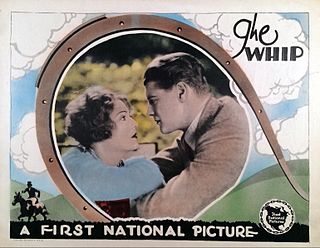
The Whip is a 1928 American synchronized sound drama film directed by Charles Brabin and starring Dorothy Mackaill. While the film has no audible dialog, it was released with a synchronized musical score with sound effects using the sound-on-disc Vitaphone process. It was based on a 1912 play The Whip by Cecil Raleigh and Henry Hamilton and distributed by First National. This sound film was released with a synchronized Vitaphone soundtrack of music and sound effects. It is set in the horse racing world of England.
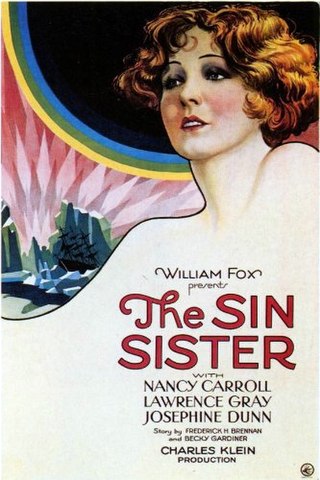
The Sin Sister is a lost 1929 American sound drama adventure film directed by Charles Klein and starring Nancy Carroll. While the film has no audible dialog, it was released with a synchronized musical score with sound effects using both the sound-on-disc and sound-on-film process. It was produced and distributed by the Fox Film Corporation.

Molly and Me is a 1929 sound part-talkie American comedy film directed by Albert Ray. In addition to sequences with audible dialogue or talking sequences, the film features a synchronized musical score and sound effects along with English intertitles. The soundtrack was recorded using the Tiffany-Tone sound system. The film stars Belle Bennett, Joe E. Brown and Alberta Vaughn.

Two Men and a Maid is a 1929 American sound part-talkie romantic drama film directed by George Archainbaud and starring William Collier Jr., Alma Bennett and Eddie Gribbon. In addition to sequences with audible dialogue or talking sequences, the film features a synchronized musical score and sound effects along with English intertitles. The soundtrack was recorded using the Tiffany-Tone sound-on-film system using RCA Photophone equipment.

New Orleans is a 1929 American sound part-talkie drama film directed by Reginald Barker and starring Ricardo Cortez, William Collier Jr., Alma Bennett. In addition to sequences with audible dialogue or talking sequences, the film features a synchronized musical score and sound effects along with English intertitles. The soundtrack was recorded using the Tiffany-Tone sound-on-film system using RCA Photophone equipment. The film was produced and distributed by the independent Tiffany Pictures.

My Lady's Past is a 1929 American sound part-talkie drama film directed by Albert Ray and starring Belle Bennett, Joe E. Brown and Alma Bennett. In addition to sequences with audible dialogue or talking sequences, the film features a synchronized musical score and sound effects along with English intertitles. The soundtrack was recorded using the Tiffany-Tone sound-on-film system using RCA Photophone equipment. After completing his first novel, a writer abandons his wife for his secretary. The film survives at BFI/National Film And Television Archive.

Midstream is a 1929 American sound part-talkie science fiction film directed by James Flood and starring Ricardo Cortez, Claire Windsor, and Montagu Love. In addition to sequences with audible dialogue or talking sequences, the film features a synchronized musical score and sound effects along with English intertitles. The soundtrack was recorded using the Tiffany-Tone sound-on-film system using RCA Photophone equipment.

Whispering Winds is a 1929 American sound part-talkie pre-Code drama film directed by James Flood and starring Patsy Ruth Miller, Malcolm McGregor and Eve Southern. In addition to sequences with audible dialogue or talking sequences, the film features a synchronized musical score and sound effects along with English intertitles. The soundtrack was recorded using the Tiffany-Tone sound-on-film system using RCA Photophone equipment.
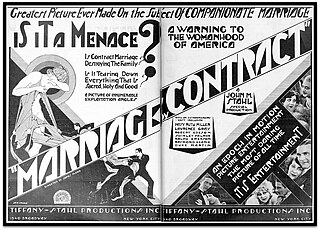
Marriage by Contract is a 1928 American sound part-talkie drama film directed by James Flood and starring Patsy Ruth Miller, Lawrence Gray and Robert Edeson. In addition to sequences with audible dialogue or talking sequences, the film features a synchronized musical score and sound effects along with English intertitles. The soundtrack was recorded using the Tiffany-Tone sound-on-film system. This film was one of the first sound films produced by Tiffany Pictures, one of the largest independent studios in Hollywood at the time, and was followed by Lucky Boy.
Take the Heir is a 1930 American synchronized comedy sound film directed by Lloyd Ingraham and starring Edward Everett Horton, Dorothy Devore and Edythe Chapman. While the film has no audible dialog, it was released with a synchronized musical score with sound effects and featured a theme song that was sung by an uncredited tenor. The film was produced during the transition to sound film and a separate silent version was also released. Location shooting took place around Broadway. A review in the Motion Picture News considered the film "very, very weak" and a waste of Everett Horton's talents.



















